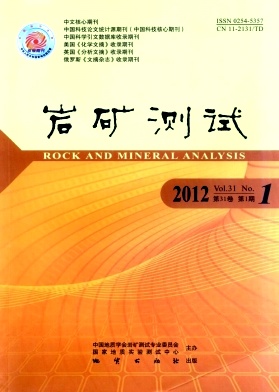ZHANG Wei-na, LU Ji-long, DUAN Tai-cheng. Determination of Impurity Elements in Fluorescent Powders by Using High Temperature and High Pressure Digestion with Bomb-Inductively Coupled Plasma-Mass Spectrometry[J]. Rock and Mineral Analysis, 2012, 31(1): 90-94.
| Citation: |
ZHANG Wei-na, LU Ji-long, DUAN Tai-cheng. Determination of Impurity Elements in Fluorescent Powders by Using High Temperature and High Pressure Digestion with Bomb-Inductively Coupled Plasma-Mass Spectrometry[J]. Rock and Mineral Analysis, 2012, 31(1): 90-94.
|
Determination of Impurity Elements in Fluorescent Powders by Using High Temperature and High Pressure Digestion with Bomb-Inductively Coupled Plasma-Mass Spectrometry
-
1.
College of Geoexploration Science and Technology, Jilin University, Changchun 130026, China
-
2.
Changchun Institute of Applied Chemistry, Chinese Academy of Sciences, Changchun 130022, China
-
3.
College of Chemistry, Jilin Normal University, Siping 136000, China
-
4.
College of Geoexploration Science and Technology, Jilin University, Changchun 130026, China
-
5.
Changchun Institute of Applied Chemistry, Chinese Academy of Sciences, Changchun 130022, China
-
Abstract
A new fast pretreatment method for crystal fluorescent powders which are digested by high temperature and high pressure ambient in bombs is discussed in this paper. The influence of four conditions: digested time, temperature, the species, and dosage of solvents on the digestion ability of four kinds of fluorescent powders, including rare earth oxides and rare earth phosphates, alkaline-earth metal aluminates and alkaline-earth metal silicates were studied. The contents of impurity elements Cu, Zn, Cd and Pb in these fluorescent powders which were digested in optimal conditions were determined by Inductively Coupled Plasma-Mass Spectrometry (ICP-MS). The results show that the optimal digestion conditions are 2 mL HCl, 120℃ and 3 h for rare earth oxide and rare earth phosphate fluorescent powder; 2 mL HCl, 160℃ and 6 h for alkaline-earth metal aluminate fluorescent powder; 2 mL HCl-0.5 mL HF, 160℃and 3 h for alkaline-earth metal silicate fluorescent powder. The major coexisting elements had no obvious influence on the determination of Cu, Zn, Cd and Pb, the method had wide linear ranges, low limits of detection and high sensitivity, and was an optimal analytical method for determining elements of phosphor crystals.
-

-
-
Access History







 DownLoad:
DownLoad: